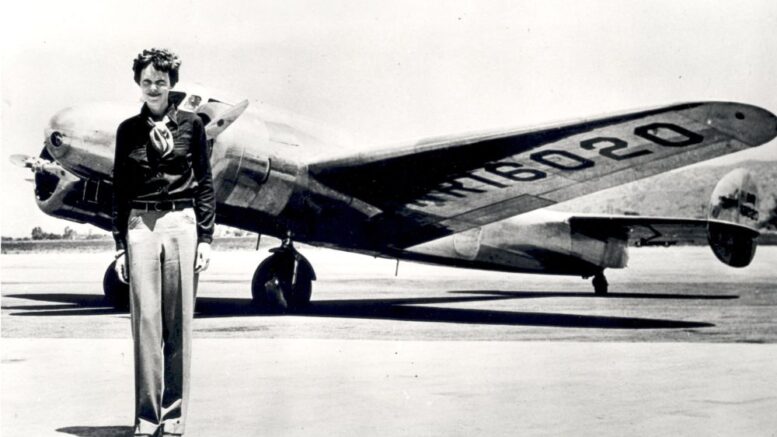Nearly 90 years after aviator Amelia Earhart vanished in the middle of the Pacific Ocean, the mystery of her crash remains unsolved. Evidence has given way to speculation, legends, and even bizarre stories — not unlike those surrounding the death of Antoine de Saint-Exupéry. What really happened on July 2, 1937, that prevented Amelia’s Lockheed Electra 10E from ever reaching its destination? Solving this mystery is like unraveling a case worthy of Sherlock Holmes — and perhaps the greatest aviation enigma of the 20th century.
The objective is clear: to locate the wreckage of a small twin-engine aircraft somewhere within 165,250,000 km² of ocean — nearly a century later. That is undoubtedly what motivated researchers in recent months to organize a new expedition following the analysis of a satellite image. The results are expected by the end of November 2025.
A Stain or an Airplane?
A suspicious mark spotted on the island of Nikumaroro in the Pacific — eerily resembling the aviator’s aircraft, the Lockheed Electra 10E — is now the subject of study. This 2015 Apple Maps satellite image, shared by Michael Ashmore, shows a peculiar shape dubbed the « Taraia Object. » It lies along the Taraia Peninsula, which extends southwest from the northern shore of the lagoon. According to the imagery, the object is located just east of Tatiman Passage, which connects the lagoon to the ocean.
And for such an unconventional story, there was an equally unconventional aviator. Amelia Earhart was not just another pilot. Known for being the first woman to fly solo across the Atlantic in 1932, she quickly became an icon. In 1937, she embarked on an even greater challenge: a round-the-world flight. With her navigator Fred Noonan, Earhart took off from Miami in June 1937 aboard her twin-engine plane.
After several stopovers, on July 2, 1937, as they were due to land on Howland Island, radio communications became erratic. The last message received indicated they were over their destination and running low on fuel. That would be the final contact before their complete disappearance.
The most probable hypothesis is that the two aviators managed to land on Nikumaroro Island, located 1,600 km from Fiji, but were never able to leave. This theory is supported by TIGHAR (The International Group for Historic Aircraft Recovery), an organization specializing in historic aircraft searches. Since 1989, several expeditions have been carried out on the island. Clues such as bones (possibly Amelia’s), a woman’s shoe, and a sextant have reinforced this line of inquiry — though the plane itself remains missing.
Evidence Supporting Amelia’s Plane
In 2020, a satellite photo taken in 2015 reignited the case. It shows a strange, partially submerged shape that reportedly appeared after a cyclone. The Purdue Research Foundation — which financed Amelia Earhart’s round-the-world flight — teamed up with the Archaeological Legacy Institute (ALI) to analyze the image. By comparing this shape with archival and newer satellite images (2016–2024), they confirmed it appeared across multiple time periods.
Thanks to funding from a small group of donors, the team obtained 26 additional satellite images spanning 2009 to 2021. The ALI later acquired three more Google Earth images covering 2022 to 2024. A video filmed in 2001 by TIGHAR, during a helicopter flyover of the peninsula, shows a solar reflection coming from the seabed — suggesting a metallic object.
A dozen expeditions conducted between 1989 and 2019 may therefore have passed close to the « precious bird » without detecting anything.
Many have speculated that the Electra, after being swept off the Nikumaroro reef by tides and waves, drifted out to sea and eventually sank into deep water. That is why, in 2019, Robert Ballard — with the support of National Geographic — carried out a deep-sea search around the island, finding no trace of the aircraft.
A Final Expedition to Solve the Mystery
Despite the Purdue Foundation’s optimism, some researchers such as Rick Gillespie of TIGHAR remain cautious, noting that previous metal-detector searches in the area had yielded nothing. The Archaeological Legacy Institute responded that « the detectors may not have been effective on this type of seabed. »
A new expedition, jointly led by the Purdue Research Foundation, the Archaeological Legacy Institute, and TIGHAR, is therefore planned for November 5. A small team will travel to this remote island to identify the « Taraia Object. »
Initial observations will be conducted non-intrusively. If the object is confirmed, underwater excavations will follow to search for debris. A research station could later be established for subsequent project phases — including larger-scale archaeological digs and, potentially, recovery of the aircraft remains.
If the « Taraia Object » does indeed prove to be the Lockheed Electra 10E, the mystery of Amelia Earhart’s disappearance could finally be solved — 88 years later.
The expedition is set to depart from Majuro, in the Marshall Islands, on November 5, 2025, spend five days on Nikumaroro to inspect the Taraia Object, and return to port on November 21.





Be the first to comment on "The Mystery of Amelia Earhart in a Stain"